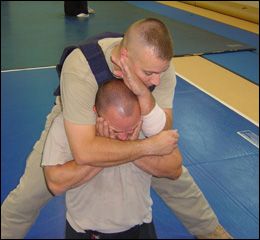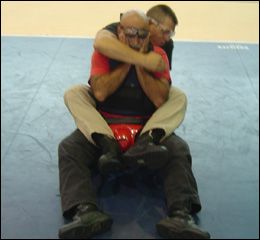You are in a fight for your life with an inmate. He has you pinned against the wall and he is punching you and slamming your head into the wall. You fall to the ground, and as he mounts you he wraps his hands around your neck and starts to squeeze. Your movements become restricted and you experience blurry vision, a slight headache, shortness of breath, tingling sensation to your legs, shoulders, knees, arms and finger tips. You realize you have a brief short moment of opportunity to do something. What do you do?
Chokes are separated into two different categories:
 |
1. Blood Choke — Pressure is |placed on |the cardiac and the blood flow is slowed down, which affects the amount of oxygen transported to the brain. When the level of oxygen needed for brain support is reduced to a lower level the subject goes unconscious.
a. The Rear Choke is an example of a blood choke. The inmate positions themselves directly behind the officer and wraps one of the arms with the forearm going around the front of the throat of the officer, and then secured with the second hand.
2. Air Choke — this is when pressure is placed to the front of the throat, or the mouth and nasal passage ways prohibiting the needed oxygen to sustain human life. Examples include:
a. Front Hand Chokes — the inmate places their hand around the front of the officer throat and squeezes.
b. Bar Arm Choke — the inmate uses their forearm or elbow to apply pressure directly to the front of the throat area.
c. Smothering — the inmate uses either a pillow or soft materials or their body to place over the officer’s face.
d. Strangulation — Parts of the officer’s clothing is twisted around the officer’s neck.
Immediate Response to Chokes
• Remain calm. Panicking will not help you get out of this, and time is of the essence.
• Protect the airway. You need to release the grip from around your neck. If possible you can do what is called the “Turtle Shell Technique,” this is what you tuck you chin down and raise your shoulders up to help support your neck.
• Stay focused on your objective. Chokes can be reapplied, so escape quickly and evaluate your force options.
• Survey the areas for possible weapons you can use or that they may have access to.
• If all else fails you can always try playing possum and collapsing to go motionless and limp giving the inmate the impression he succeeded.
Weapons of Opportunity
 |
Let’s take a look at the possible weapons that may be available to an officer who is being choked:
1. Biting whatever is in front of our mouth.
2. Your fingers into the inmates eyes.
3. Head butting with the back of your head.
4. Slamming their body into a wall or other hard objects like door knobs, pay phones, rails to stairs etc..
5. Break anything within reach. This includes fingers, ankles, knees, legs or toes.
6. Sticking your pen or other hard object into the inmates eyes or throat area.
7. Changing your environment if you are standing and nothing is working try going to the ground and using it as an impact weapon, or down the stair case.
8. When all else fails goes completely limp, play possum and wait for an opening
In my last 25 years studying, researching, practicing and teach various forms of officer survival tactics I have learn one important thing. “If you don’t train today for your opponent today you may be giving them a shot at the title tomorrow!”
Stay safe, stay strong and most importantly: Stay Alive!


